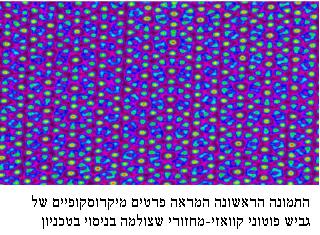This was published by the scientific journal Nature
The Technion

The Technion researchers created a quasi-periodic photonic crystal that reacts dynamically to the light passing through it. They deliberately introduced a defect into the crystal, and showed, in real time, how the crystal repairs itself through the dynamic interaction with light. This is what the prestigious journal "Nature" reveals in its issue dated April 27, 2006.
The research was conducted by PhD student Barak Friedman, under the direction of Professor Moti Segev from the Technion Physics Faculty. The other authors of the article are Guy Bartel, another doctoral student in Segev's research group, Dr. Jason Fleischer, who was a postdoctoral student in the group and is now a professor at Princeton University in the USA, Professor Dimitri Christodoulides from the University of Florida, and Dr. Ron Lipshitz from Tel Aviv University ( expert in the theory of quasi-crystals).
"A normal crystal consists of a single building stone with which a volume (or surface) can be filled in a cyclical manner, like the square tiles that pave the bathroom," the researchers explain. "But, nature found additional ways to fill volume, if more than one building block is used. In such situations, the volume (or surface) is still ordered, but the order is not cyclic. Such structures are called quasi-crystals (short for quasi-periodic crystals), and they have wonderful unique properties."
The existence of quasi-crystalline materials was discovered in 1982 by another researcher from the Technion, Professor Danny Shechtman, from the Faculty of Materials Engineering. The discovery that crystals do not have to have a periodic structure was a scientific revolution at the time.
Light waves passing through the photonic quasi-crystal created by Technion researchers react as electrons and atoms behave in a quasi-periodic crystal in nature. The quasi-periodic photonic crystal changes its properties as light passes through it. That is, the light beam passing through such a crystal causes a change in the properties of the crystal, and this change causes a change in the light beam, and God forbid, in a dynamic way. The significant difference between a photonic quasi-crystal with dynamic properties and quasi-periodic crystals in nature is that in the photonic crystal it is possible to observe the dynamics inside the crystal in real time, as the Technion researchers did in the experiment with the self-correcting defect. That is, in this way it is possible to learn about quasi-periodic structures in ways that were impossible until now. New insights into the electrical, optical, elastic, and other properties of this type of material could lead to new uses that were not known until now.
Alongside the article by Professor Segev and his partners, "Nature" publishes a short article about Professor Segev's laboratory and the research atmosphere there.
